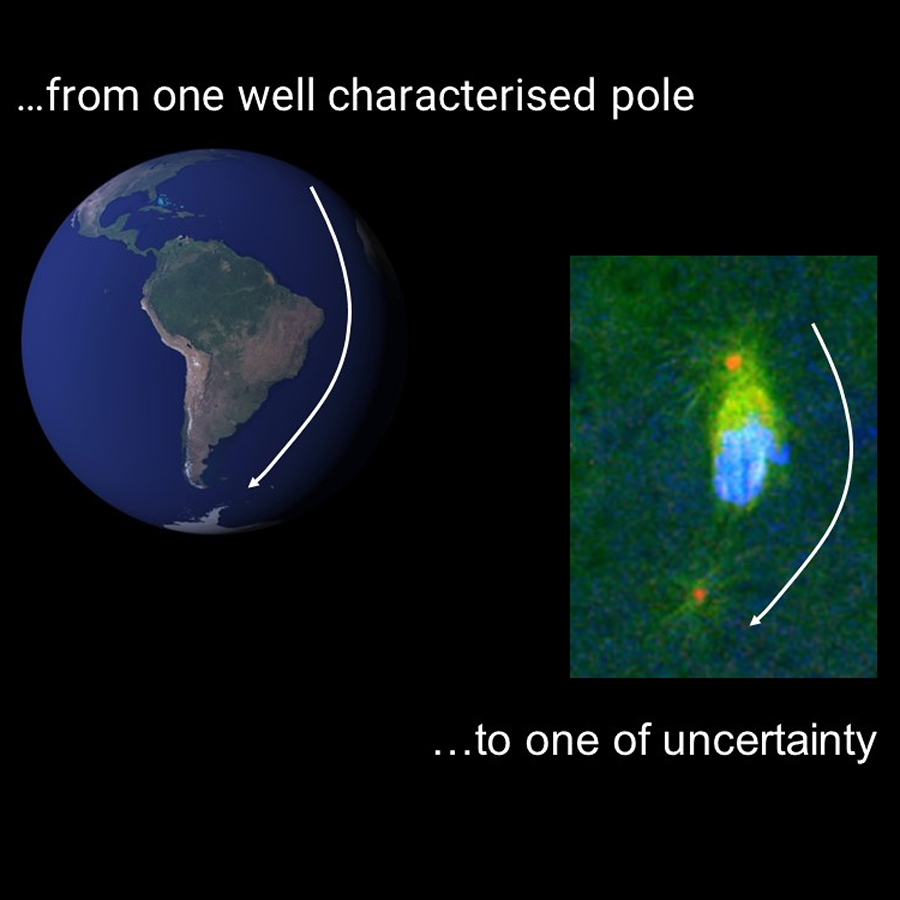Our research: what we did
Syncytial Drosophila embryos undertake 13 nuclear division cycles in two hours driven by a maternal dowry of cell cycle regulatory proteins. Here, microtubules are stained red and kinetochores, blue.
Centrosomes and their ‘maturation’ at mitotic entry were described by Boveri in the 1880s as bodies that enlarged upon mitotic entry at the spindle poles – the phenomenon of centrosome maturation.
The Glover lab began working on centrosomes a century later using Drosophila as a model in which to identify regulators of the mitotic apparatus. One of our approaches was to search for mutant genes that when homozygous in the mother resulted in defects in the rapid nuclear division cycles of the syncyntial embryo. By the end of the 1980s we had identified several such maternal-effect-lethal mutants that showed abnormal spindle pole behaviour including the genes for the Polo and Aurora A kinases; we named these reflecting phenomena at the geomagnetic poles of the earth.
A cultured Drosophila cell expressing Polo-GFP in mitosis. Polo kinase associates with centrosomes, kinetochores, the central spindle, and finally the midbody at cytokinesis.
We found that centrosome maturation requires the activity of Polo kinase that both activates the Abnormal Spindle protein (Asp) and also promotes the recruitment of peri-centriolar material including centrosomin and the γ-tubulin ring complex. Together these latter molecules nucleate and organize the minus ends of microtubules in the centrosome.
As cells progress through mitosis, Polo kinase dashes from one site to another to execute its long to-do list. It is strongly associated with the centrosome at mitotic entry, moves to the kinetochore to help regulate the spindle assembly checkpoint and, as a consequence, it helps regulate the onset of anaphase. It is finally transferred onto the central region of the spindle where it orchestrates cytokinesis. These functions are highly conserved and in fact we demonstrated the cytokinesis function of Polo in fission yeast first, then showed the same requirement in Drosophila.

Loss of a centrosome from one spindle pole in Scant (Scott of the Antarctic)-derived embryos.
We found that Aurora A kinase phosphorylates the conserved D-TACC protein promoting its association with spindle poles in complex with Minispindles (Msps), a homologue of the microtubule-associated protein ch-TOG; this protein is upregulated in several tumour types. Mutants of Aurora A have monopolar spindles, reflecting its function of activating one of the major mitotic motors that maintains spindle bipolarity.
We then found another related kinase, Aurora B, which phosphorylates Histone H3 and is required to recruit condensins upon chromosome condensation. Aurora B is also required at the kinetochores to regulate the spindle assembly checkpoint as part of the Chromosome Passenger Complex. This complex is transferred from the chromosomes to the central spindle at the metaphase-anaphase transition where it is also required in concert with Polo for cytokinesis. The spindle undergoes several changes in these late mitotic stages. First it elongates during late anaphase and then undergoes a more profound re-organisation with the formation of the central spindle, an overlapping array of microtubules that organises cytokinesis. Various motors and microtubule-associated proteins help mediate these transitions and these are in part regulated by the Aurora and Polo kinases.
In the cytokinesis of a typical animal cell, a cleavage furrow forms at the cell’s equator and ingresses to bisect the dividing cell. We have studied how central spindle microtubules deliver the kinesin-like protein Pavarotti and its associated signalling molecule RacGAP to initiate furrow formation and how the Rho and Rac GTPases antagonistically regulate functions of STICKY/citron kinase to coordinate the correct organisation of F-actin and Anillin in the contractile ring.
Last but not least, we unknowlingly identified another key mitotic protein kinase, Greatwall, through the Drosophila mutation Scant. When Scant is present as a single copy in females that also have only a single copy of the wild-type polo gene, those females are sterile due to mitotic defects in the embryo. Scant turned out to encode a constitutively active form of Greatwall kinase whose main substrate becomes an inhibitor of a form of In the cytokinesis of a typical animal cell, a cleavage furrow forms at the cell’s equator and ingresses to bisect the dividing cell. We have studied how central spindle microtubules deliver the kinesin-like protein Pavarotti and its associated signalling molecule RacGAP to initiate furrow formation and how the Rho and Rac GTPases antagonistically regulate functions of STICKY/citron kinase to coordinate the correct organisation of F-actin and Anillin in the contractile ring.Protein Phosphatase 2A (PP2A), which inhibits mitotic entry and dephosphorylates mitotic proteins. Thus activation of Greatwall kinase contributes to mitotic progression.
Over recent years, our research has focused upon a protein kinase that is active at the end of mitosis. This is a relative of Polo known as Plk4; it is required for the duplication of centrioles, the 9-fold symmetrical organelles found in the core of the centrosome and at the base of cilia and flagellae. Our efforts to study the role of Plk4 are described in ongoing projects.